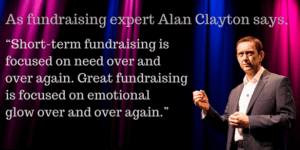Everyone Wants to be a Hero: Creating a Donor Journey that Wins

Throughout history, the hero’s journey is a story told thousands of times, yet it never gets boring or old.
It’s that archetypal journey that all protagonists go through and has been used to describe everyone from Jesus Christ and Odysseus to modern heroes like Luke Skywalker and Harry Potter. To explain very briefly, the cyclical journey begins with a call to adventure — such as discovering the hologram of a princess in distress (“Help me Obi-Wan Kenobi, you’re my only hope”) or an initiation to a magical wizarding school (“You’re a wizard, Harry!”). The initial call is followed by trials and tribulations, usually culminating in a great battle with an antihero (The Empire or Lord Voldemort), until the hero returns home, changed and strengthened (as a Jedi or a wizard). Think about any great, epic movie or book, and chances are you’ll see echoes of this cycle in every one.
Now let’s think about the story of your nonprofit. The hero of your story is the donor, who actually goes through a similar journey. From the call to adventure (the call to action) to the trials and tribulations (anything that may stop them from donating) to the return home (hopefully as a loyal donor and advocate of your cause), every communication between you and your donor contributes to the quality of their journey and determines whether or not they will take that road again. Though the donor journey, like the hero’s journey, follows a typical path, we must avoid the temptation to see every donor as identical. Though the journey may be similar, your donors are as dissimilar to one another as Odysseus, Luke Skywalker, and Harry Potter.
Therefore, your goal must be to create an easy and seamless journey for each of your donors that is not “one-size-fits-all.” To do this, you must involve every member of your fundraising crew: marketers, programmers, copywriters, designers, and volunteers. Only together can you create a donor journey that can serve all your “heroes” while still treating them as individuals. So let’s set out on this journey, discovering ways to improve the process along the way.
The Call To Adventure
In the mythic hero’s journey, the hero is called to something great and initially refuses. They hesitate at the power or responsibility of the journey, but then something happens that convinces them that they must set out to make things better. So it may be with your donors. They may “refuse the call” the first time around. Perhaps they feel they are too busy or don’t think they have the budget to support your cause. But strong and consistent calls to action can show them that they have power and must make a difference. Remember, this is the initial contact between you and your potential donor on their journey, and it must be extremely convincing. The first step is to make sure that the call to action comes in the right channel, the channel that the donor is most likely to respond to. As you become more familiar with your donors, you can and should make sure that any contact with them is in their preferred channel. Whether it is through direct mail, email, social media, on a billboard, or face to face, a strong call to action should tell a story, feel urgent, and make the donor feel the potential of heroism — like they will really add value by taking the next step. Content and design play a huge role in calling your donor to action. Content must be specific, personalized, and donor-centric, putting the focus on exactly what the donor can achieve with their support. And be clear in what you are asking for. Marketing expert John Haydon even suggests removing the word “donate” from your call to action altogether and instead replacing it with more specific calls: Feed hungry families, Stop violence, Give clean water, etc. No matter what it says, make it prominent — because in a world full of distractions, you have a very limited window of time in which to grab and retain your prospective donor’s attention. Which leads us to …
The Road of Trials
In Homer’s The Odyssey, Odysseus sets out on his journey home after the Trojan War, only to be distracted by many foes: Poseidon’s rough waters, the monster Cyclops, the distracting and deadly Sirens. And Harry Potter has seven books worth of trials and tribulations! In the donor journey, however, the “monsters” that donors face are any “friction” that could possibly distract or dissuade them from donating. For example, videos are an amazing way to tell a story and gain a prospect’s empathy. But too many videos or long buffer times can frustrate and distract potential donors, leading them to abandon the journey. And in a world where donors are increasingly making more and more donations from their mobile devices, webpages that are not optimized for the mobile experience are a great way to cause your prospects to abandon ship. Depending on the channel, roadblocks to completing the donor journey could be slow page load times, broken or missing links, or copy that is too long or full of typos. Other difficulties might be a donation button hidden “below the fold,” an overwhelming amount of fields on the donation form, or unclear and confusing instructions. Utilizing testing can help you narrow down what you donors want and need to complete a successful donation, while creating a smooth and intuitive interface and having an amazing, easy-to-reach customer service team that is available every step of the journey are ways to help your donor around any roadblocks or distractions. Before you roll out something new, put yourself in your donor’s shoes and make a donation to your own organization. Actually go through the entire process yourself and notice anything that would possibly distract you from completing your donation: confusion around inconsistent messaging, graphics that are too big or distracting, slow load times, even garish colors. Focus on eliminating these things to make the donor experience simpler and more pleasant. Finally, build trust in your website by making sure everything is spelled and formatted correctly and by displaying badges and certificates that prove your site is safe and secure, like Norton, Better Business Bureau, and McAfee. Perhaps add something about the messaging not being appealing or relevant to them as an example.
The Triumphant Return
You got someone to donate! Yay! The hard part is over, right? Wrong. They still haven’t reached the ultimate goal in their journey. The goal of every nonprofit should be to make the donor journey so smooth and satisfying that donors will not mind taking it over and over again. By creating loyal donors that trust your organization, donations won’t be dependent on natural disasters, holidays, or a particularly clever call to action. People will continue to donate when they feel a partnership with your organization. But this won’t happen unless the donor feels like being a part of your cause has improved or changed them in some way.

When your cause gives donors that “emotional glow” after donating, donors will feel heroic and be inspired to set out on that journey again. To ensure this happens, make sure your donors feel necessary and appreciated by acknowledging their gift. Thanking your donor in a timely, personal, and specific way is one of the easiest ways to guarantee subsequent gifts. For some examples of how to thank your donors in any channel, go here. In addition to thanking donors for taking a journey with you, keep them updated on what their help means for your cause with scheduled newsletters or email stories from people whose lives were touched thanks to your donor’s gift. Seeing how essential their gift was, and how is was used to provide support, will make them feel entrenched in your organization and will go a long way toward future donations.
In all the great myths and stories, the heroes rarely complete their journeys on their own: Luke had Han Solo and Chewbacca while Harry had Ron and Hermoine. Your donors should not be out there alone on their journey. They should have you. So remember to be there for your donors along the way. Listen to them, regard them as partners, and adjust your strategy to meet their ever-evolving needs. People give because they want to be a part of a story much larger than themselves. So get out of your silos and come together as an organization to create a journey that is seamless, clear, and inspiring, allowing your donors to be the heroes of the fundraising story.
